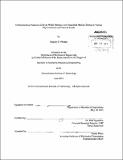Terramechanical analysis of rover wheel mobility over simulated Martian terrain at various slip conditions and vertical loads
Author(s)
Puszko, Gregory D
DownloadFull printable version (5.203Mb)
Other Contributors
Massachusetts Institute of Technology. Department of Mechanical Engineering.
Advisor
Karl Iagnemma.
Terms of use
Metadata
Show full item recordAbstract
Unmanned Mars rovers are presented with the unique challenge of requiring autonomous driving control over rough, adverse territory. A software package, dubbed Artemis, was developed in order to model the expected forces and torques on a rover's drive wheels while traveling across unfamiliar Martian terrain. However, experimental testing must be done in order to validate this theoretical model. A test rig was developed by MIT's Robotic Mobility Group to measure the forces and torques on a single rover wheel as it traverses across a soil simulant of the Martian surface, and compared that measured data to the hypothetical results predicted by Artemis. A significant portion of this work is dedicated toward the determination of the proper soil simulant to use in the test rig. Several compositions of Mauricetown NJ70 material and SilCoSil 250 Ground Silica were tested in a direct shear test in order to distinguish the properties of the material at various concentrations. With its high residual stress, low peak strength, and large internal friction angle, a mixture of 75% NJ70 with 25% SilCoSil by weight was selected as the Martian soil simulant. The experimental data revealed that as slip values and vertical loads on the rover wheel increases, values for drawbar force, wheel torque, and sinkage generally increase as well, which are the same trends predicted by the Artemis software package. Supplementary testing will need to be completed for additional slip levels and vertical loads to further substantiate the results of the Artemis software. Moreover, additional testing should be done to characterize the test soil's properties, to directly compare the results of the Artemis model to the experimental figures.
Description
Thesis (S.B.)--Massachusetts Institute of Technology, Department of Mechanical Engineering, 2013. Cataloged from PDF version of thesis. Includes bibliographical references (pages 44-45).
Date issued
2013Department
Massachusetts Institute of Technology. Department of Mechanical EngineeringPublisher
Massachusetts Institute of Technology
Keywords
Mechanical Engineering.